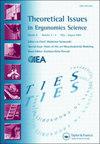Analyzing work-as-imagined and work-as-done of incident management teams using interaction episode analysis
IF 1.4
Q4 ERGONOMICS
引用次数: 0
Abstract
Abstract Resilience is an important attribute of incident management teams (IMTs) for managing disasters. Previous research on resilience of IMTs has focused on comparing work-as-imagined (WAI) and work-as-done (WAD) but predominantly used narrative analyses which limited comparisons between IMTs. This paper presents a novel Interaction Episode Analysis (IEA) method to identify the IMT’s WAI and WAD episodes by analyzing dynamic interactions that occur between different roles that carry out information management tasks. Observations and audio-visual recordings of two high-fidelity IMT exercises were conducted to capture WAD episodes, and semi-structured interviews with experts elicited corresponding WAI episodes. Quantitative analyses using five interaction-based measures were conducted to detect differences of the WAD episodes between two IMTs. Next, qualitative analyses were focused on identifying reasons why such differences have occurred by comparing the gaps between WAI and WAD episodes. Some of the reasons for WAI-WAD gaps included the non-occurrence of critical interactions that were expected and occurrence of unexpected interactions between IMT members. This paper also identifies cases of preparatory, proactive, and reactive performance adjustment that characterizes IMT resilience. The IEA method shows promise for investigating how and why the gaps between WAI and WAD in IMTs occur. With the identification of these gaps, future research can be conducted to reconcile the gaps between WAI and WAD episodes, and thus enhance resilience of IMTs in future disasters.使用交互事件分析分析事件管理团队的想象工作和已完成工作
摘要弹性是事件管理团队(IMTs)管理灾害的重要属性。以往的弹性研究主要集中在比较想象工作(WAI)和完成工作(WAD),但主要采用叙事分析,限制了imt之间的比较。本文提出了一种新的交互事件分析(IEA)方法,通过分析执行信息管理任务的不同角色之间发生的动态交互,来识别IMT的WAI和WAD事件。对两次高保真IMT练习进行观察和视听记录,以捕捉WAD发作,并与专家进行半结构化访谈,得出相应的WAI发作。使用五种基于相互作用的测量方法进行定量分析,以检测两个imt之间WAD发作的差异。接下来,定性分析的重点是通过比较WAI和WAD发作之间的差距来确定发生这种差异的原因。WAI-WAD差距的一些原因包括没有发生预期的关键相互作用,以及IMT成员之间发生了意外的相互作用。本文还确定了具有IMT弹性特征的准备、主动和反应性绩效调整的案例。IEA的方法有望调查IMTs中WAI和WAD之间的差距是如何以及为什么发生的。随着这些差距的确定,未来的研究可以进行调和WAI和WAD事件之间的差距,从而提高imt在未来灾害中的恢复力。
本文章由计算机程序翻译,如有差异,请以英文原文为准。
求助全文
约1分钟内获得全文
求助全文

 求助内容:
求助内容: 应助结果提醒方式:
应助结果提醒方式:


